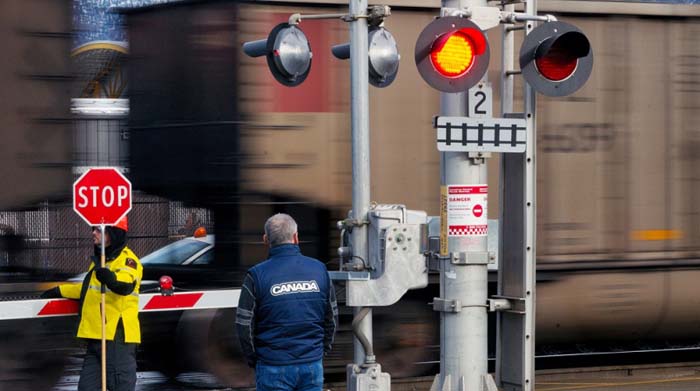
Kamloops British Columbia - Kamloops has been called a hub city, a transportation gateway between the Lower Mainland and the rest of the
country.
It boasts bustling highways, two rivers, and CP and CN railways, complete with a multi-block railyard situated right in the middle of the downtown
core.
Though undoubtedly part of the city's fabric, municipal politicians say residents are increasingly paying the price of economic growth across the country, with
more goods travelling through Kamloops.
"Yes to prosperity," Coun. Bill Sarai said.
"But it's also impacting our community. We want Canada to prosper, but we shouldn't be penalized for it."
Residents and elected officials have taken note of more frequent and longer trains in the past year, leading to increased wait times at rail crossings in
Brocklehurst, Rayleigh, Valleyview, Dallas, downtown, and Mission Flats.
Wait times vary, but based on accounts given to this newspaper, most reported wait times of concern centre around the 20 minute mark.
Some people have reported significantly longer wait times.
City councillors say longer trains are due to a strong Canadian economy, but specifically pinpoint growth in oil-by-rail.
CN, the country's largest railroad operator, reported its highest-ever quarterly revenue in July, driven in part by crude delivery by rail.
The railway company hit 200,000 barrels a day in June, compared to 150,000 barrels a day in April.
Kamloops Coun. Mike O'Reilly reiterated that Kamloops is "bearing the brunt" of the country's economic growth, with impacts on local commerce and
residents' safety.
Employees and transport trucks are being stopped multiple times throughout the day as they wait for lengthy trains to pass.
Those who live beyond the tracks feel trapped and worry about what will happen in the event of an emergency situation.
Both Sarai and O'Reilly are calling for support from the provincial and federal governments.
O'Reilly spearheaded a request to meet B.C. Transportation Minster Claire Trevena on the issue at this fall's Union of BC Municipalities convention in
Vancouver.
The city has yet to receive a reply.
O'Reilly wants to request a safety study that looks at expanding left-hand turn lanes on the Yellowhead and Trans-Canada highways, due to traffic backing up
down the highways while vehicles wait near crossings for trains to pass.
CP tossed the baton to the Ministry of Transportation when asked by Kamloops This Week (KTW) about concerns linked to traffic backed up on Highway 1 as a
result of trains blocking the Kelly Douglas Road crossing in Valleyview.
CP essentially said it's a highways issue, not a rail issue, despite trains being the root of the problem.
The Ministry of Transportation has said it is working with the city and railway to review traffic signals in the area, but there has been no mention of
expanding the turn lane.
Kamloops South-Thompson MLA Todd Stone noted railways fall under federal jurisdiction, with legislation giving railways significant power.
Stone said the province can advocate to federal Transport Minister Marc Garneau about safety and delay concerns at railway crossings, something he said he did
when he was B.C.'s former transportation minister.
If there is a significant safety issue, the province can partner with the federal government on infrastructure, including overpasses, Stone said.
"But even that is very, very, complicated and time consuming because the railways have a very significant amount of power as per the legislation, that's
federal, in place," Stone said.
"As a province, you can't really do anything without the full support of the federal government. Even with that, it requires a lot of discussion and
co-operation with the railways."
Under federal regulations, railways cannot block public rail crossings for more than five minutes to vehicles and pedestrians.
That rule is null and void, however, when the train is moving.
Transport Canada does note railway companies must clear crossings as quickly as possible when emergency vehicles need to get through and maintains its role is
to monitor rail companies for compliance of those rules through audits and inspections.
"If an inspection reveals that a company is not following the rules, Transport Canada does not hesitate to take appropriate action, which is based on the
severity of the safety issue and can involve one or more of several compliance and enforcement tools," Transport Canada stated in a email to
KTW.
Still, that does little to mitigate wait times or safety concerns of Kamloops residents, according to those with whom KTW has spoken.
O'Reilly said he spoke with Garneau in recent months, with Garneau saying he hadn't heard of rail concerns in Kamloops.
"I made him aware of that and he kind of said, put something together, what you ask," O'Reilly said.
That's where it's going, to be looking to do studies and figure out what is a best solution for Kamloops to deal with this rail problem.
"Because it's not going to get better. It's only going to get worse as we go, so it's something that needs to be looked at now. It's a long-term program,
but it's something that needs to be addressed currently."
Kamloops-Thompson-Cariboo MP Cathy McLeod was unavailable for an interview during compilation of these stories.
Jessica Wallace.
provisions in Section 29 of the Canadian
Copyright Modernization Act.


